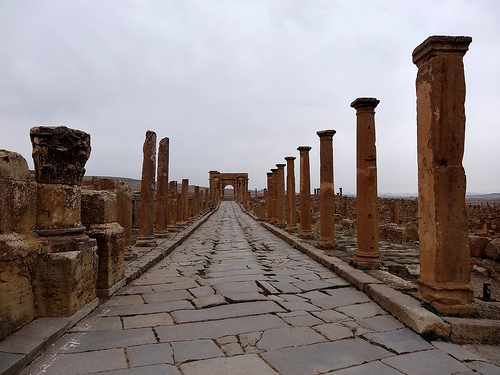

Location: Bni Hamden, Constantine Province Map
Entrance Fee: DA20, children DA10
Open: 8am- 4pm
Tiddis is an ancient Roman settlement situated near Bni Hamden
village in the Constantine Province of Algeria. Tiddis also known as
Castellum Tidditanorum or Tiddi is an ancient Roman city constructed
in the 4th century BC. Its baths, gates, city walls, as well as
other beautiful religious, commercial and residence building present
tourists with a rear opportunity to view Roman planning unhindered
by later houses, or extensive looting by the locals. Thanks to its
isolate location Tiddis managed to avoid destruction by later
generations.
Some historians and archeologists call the
settlement "city of gods". Tiddis has numerous temples and churches
dedicated to various religious. This includes traditional Roman gods
like Vesta and Ceres, later cults of Mirtha and Carthaginian Baal
Hammon. many of the pagan temples were later converted to Christian
churches as a new religion spread through the region. It became a
dominant religion in the region dominated by large and prosperous
urban centers. Additionally Tiddis was a seat of a Christian bishop
as early as a 5th century.
Tiddis was built by the Romans and organized according to their
urbanization system.
This prosperous city, located on a plateau,
had a monumental gate, baths, industrial facilities (tanneries), a
Mithraist sanctuary dating from the 4th century BC. and also a Christian
chapel.
The hometown was Romanized like the other towns near
Cirta. Today you can cross it by following the main street that goes
from a monumental portal between the houses, passing through the forum,
a small square and the curia. The magistrates and decurions of the
castellum are known from the inscriptions. It belonged to the colony of
Cirta and, with the other colonies of Russicade, Milev and Chull, was
part of the confederation of the IV colonies. Also among the public
monuments cleared so far are public baths and cisterns (built by M.
Cocceius Anicius Faustus in the mid-3rd century AD) and on the top of
the rock a Temple of Saturn (which produced a large number of stelae now
in the Constantine Museum). On the slopes of the cliff you can see many
houses and the remains of the original castellum wall. The Lolios were
one of the important families of the city. His circular mausoleum can
still be seen a few kilometers to the N. The monument was erected by
Lollius Urbicus, prefect of the city of Rome under Antoninus Pius. At
the end of the fifth c. It is known that the city was the seat of a
bishopric. Two Christian basilicas have been cleaned. One was located at
the entrance to the town; the other was in a more distant district and
has only been partially cleared
Richard Stillwell
Castles and
water tanks of all shapes give indications that the city has been
gradually abandoned due to lack of water supply sources. You can admire
the mausoleum of Quintus Lolio Urbicus, a native of Tiddis (and son of a
Romanized Berber landowner) who later became prefect of Rome.
Today, Tiddis is an authentic Roman site called Res eddar or the "house
peak" located in the Kheneg Gorge, just north of Cirta. It marks the
presence of a Roman civilization through rock art inscriptions and Roman
pottery .
Under Byzantine control, Castellum Tidditanorum had two small
churches and was the seat of a diocese.
Morcelli assigns four
bishops to this see, but Mesnage and Jaubert believe that they were
bishops of Tisedi, leaving only
Abundius, who attended the Council of
Carthage convened in 484 by King Hunericus of the Vandal kingdom, later
went into exile like most Catholics, unlike their Donatist schismatic
heretical counterparts.
The Christian community probably disappeared
with the Muslim conquest in the second half of the 7th century, but some
pottery remains showed the survival of a small village within the ruins
of Tiddis until the 9th century.
Tiddis is famous for its pottery which is among the most beautiful in
Berber art. Its style is distinguished by a triangular geometric
decoration, similar to that found in contemporary Kabyle pottery.
Tiddis' style is accompanied by motifs representing birds, plants and
stylized humans, sometimes reduced to simple triangles. This style has
experienced great expansion in North Africa: in eastern Algeria, north
of Aurès and Nemencha, in Kabylia, north of Tunisia, in Ouarsenis and
the eastern Rif.
During the Muslim period, Tiddis is still known
for its art, there are magnificent glazed pottery.
The excavations were directed by the archaeologist André Berthier who
devoted himself (from 1940 to 1973) to the excavation and exhaustive
study of this city.
The ancient city is well preserved, the site
was classified in 1992. It is today under the supervision of Ogebc
(Office for the management and exploitation of cultural property). Of
the 40 hectares that make up the ancient city, only 7 hectares have been
excavated and listed. The excavations have led to the discovery of
several vestiges of the Roman city: temples dedicated to divinities, a
forum, paved roads, neighborhoods of artisans, thermal baths and water
reservoirs. Pieces from the site are on display at the Cirta National
Museum.
The ruins are divided into three zones: the first
occupying the plateau, the second, the eastern slope, the third, the
foot of the cliff. The plateau is divided into two parts separated by a
wall starting from the highest point called Ras El Dar. Only the eastern
part of the plateau was built4. Basically, the higher you go, the more
you find older areas of the city.